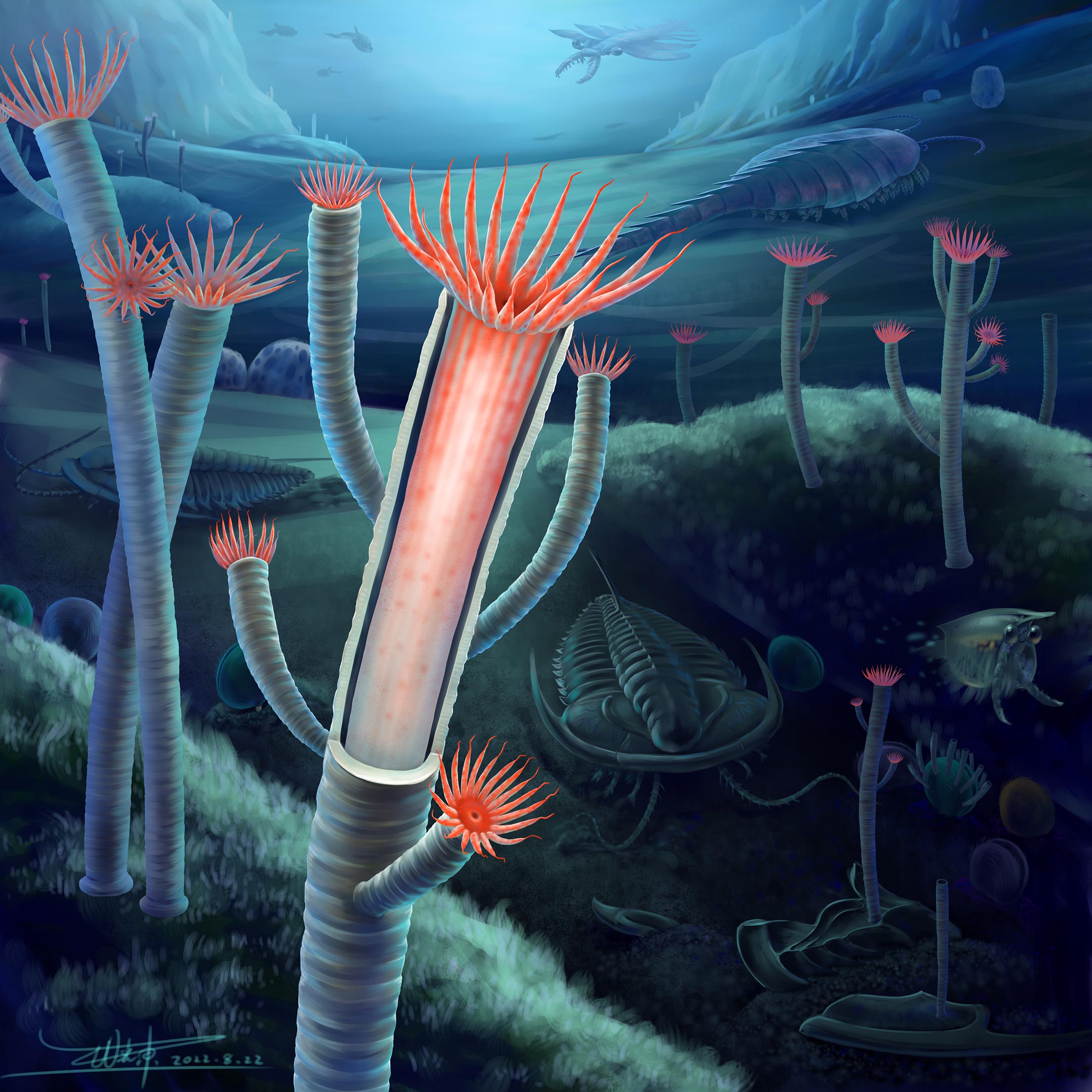
إعادة بناء فنان لـ Gangtucunia aspera ، التي ظهرت في قاع البحر الكمبري منذ حوالي 514 مليون سنة. الشخص الموجود في المقدمة لديه جزء من الهيكل العظمي تمت إزالته لإظهار الورم الرخو داخل الهيكل العظمي. الائتمان: إعادة الإعمار بواسطة Xiaodong Wang
تمكن العلماء أخيرًا من حل لغز عمره قرون في تطور الحياة على الأرض ، وكشفوا كيف ظهرت أول الحيوانات التي طورت الهياكل العظمية. أصبح هذا الاكتشاف ممكناً بفضل مجموعة من الأحافير المحفوظة جيدًا بشكل استثنائي والتي عُثر عليها في مقاطعة يونان بشرق الصين. نُشرت نتائج الدراسة في 2 نوفمبر في مجلة Science وقائع الجمعية الملكية ب.
منذ حوالي 550-520 مليون سنة ، خلال حدث يُعرف باسم الانفجار الكمبري ، ظهرت فجأة أولى الحيوانات التي طورت هياكل عظمية صلبة وقوية في غمضة عين في السجل الجيولوجي. معظم هذه الحفريات المبكرة عبارة عن أنابيب مجوفة بسيطة يتراوح طولها من بضعة مليمترات إلى عدة سنتيمترات. ومع ذلك ، يكاد يكون من غير المعروف تمامًا نوع الحيوان الذي صنع هذه الهياكل العظمية ، لأنها لا تحافظ على الأجزاء اللينة اللازمة لتحديدها على أنها تنتمي إلى المجموعات الرئيسية من الحيوانات التي لا تزال على قيد الحياة حتى اليوم.

عينة أحفورية (يسار) ومخطط (يمين) من Kangtugunia aspera ، والتي تحافظ على الأنسجة الرخوة بما في ذلك الأمعاء والمخالب. الائتمان: لوك باري وجوانجسو زانج
أربعة نماذج جانجتوجونيا أسبيرا المجموعة الجديدة المكونة من 514 مليون عام من الأحافير لا تزال تحتوي على أنسجة رخوة ، بما في ذلك الأمعاء وأجزاء الفم ، سليمة. تكشف هذه الأنواع أن لها فمًا حلقًا مع مجسات ناعمة بدون فروع يصل طولها إلى 5 مم (0.2 بوصة). ربما تم استخدامها لطعن الفريسة والتقاطها مثل المفصليات الصغيرة. تظهره الأحافير أيضًا جانجتوكونيا أعور (يفتح من طرف واحد فقط) ، مقسم إلى تجاويف داخلية تملأ طول الأنبوب.
تم العثور عليها اليوم فقط في قناديل البحر الحديثة وشقائق النعمان وأقاربها (تسمى الكائنات المجوفة) ، وهي أندر المخلوقات الرخوة في سجل الحفريات. أظهرت الدراسة أن هذه الحيوانات البسيطة كانت أول من طور الهياكل العظمية الصلبة التي تشكل الجزء الأكبر من السجل الأحفوري المعروف.
وفقًا للباحثين ، جانجتوكونيا يشبه في مظهره سلائل قنديل البحر scyphozoan الحديثة ، يرتبط هيكل أنبوبي صلب بالركيزة. يمتد فم اللامسة خارج الأنبوب ، ولكن قد يتم سحبه داخل الأنبوب لتجنب الحيوانات المفترسة. على عكس الزوائد اللحمية لقنديل البحر الحية ، الأنبوب جانجتوكونيا فوسفات الكالسيوم هو المعدن الصلب الذي يتكون من أسناننا وعظامنا. أصبح استخدام هذه المواد في صنع الهياكل العظمية نادرًا جدًا بين الحيوانات بمرور الوقت.

لقطة مقرّبة لأجزاء فم Kangtukunia aspera تُظهر المجسات المستخدمة في التقاط الفريسة. الائتمان: لوك باري وجوانجسو زانج
الكاتب المراسل د. لوك باري ، قسم علوم الأرض ،[{” attribute=””>University of Oxford, said: “This really is a one-in-million discovery. These mysterious tubes are often found in groups of hundreds of individuals, but until now they have been regarded as ‘problematic’ fossils, because we had no way of classifying them. Thanks to these extraordinary new specimens, a key piece of the evolutionary puzzle has been put firmly in place.”
The new specimens clearly demonstrate that Gangtoucunia was not related to annelid worms (earthworms, polychaetes and their relatives) as had been previously suggested for similar fossils. It is now clear that Gangtoucunia’s body had a smooth exterior and a gut partitioned longitudinally, whereas annelids have segmented bodies with transverse partitioning of the body.
The fossil was found at a site in the Gaoloufang section in Kunming, eastern Yunnan Province, China. Here, anaerobic (oxygen-poor) conditions limit the presence of bacteria that normally degrade soft tissues in fossils.

Fossil specimen of Gangtoucunia aspera preserving soft tissues, including the gut and tentacles (left and middle). The drawing at the right illustrates the visible anatomical features in the fossil specimens. Credit: Luke Parry and Guangxu Zhang
PhD student Guangxu Zhang, who collected and discovered the specimens, said: “The first time I discovered the pink soft tissue on top of a Gangtoucunia tube, I was surprised and confused about what they were. In the following month, I found three more specimens with soft tissue preservation, which was very exciting and made me rethink the affinity of Gangtoucunia. The soft tissue of Gangtoucunia, particularly the tentacles, reveals that it is certainly not a priapulid-like worm as previous studies suggested, but more like a coral, and then I realised that it is a cnidarian.”
Although the fossil clearly shows that Gangtoucunia was a primitive jellyfish, this doesn’t rule out the possibility that other early tube-fossil species looked very different. From Cambrian rocks in Yunnan province, the research team has previously found well-preserved tube fossils that could be identified as priapulids (marine worms), lobopodians (worms with paired legs, closely related to arthropods today), and annelids.
Co-corresponding author Xiaoya Ma (Yunnan University and University of Exeter) said: “A tubicolous mode of life seems to have become increasingly common in the Cambrian, which might be an adaptive response to increasing predation pressure in the early Cambrian. This study demonstrates that exceptional soft-tissue preservation is crucial for us to understand these ancient animals.”
Reference: “Exceptional soft tissue preservation reveals a cnidarian affinity for a Cambrian phosphatic tubicolous enigma” by Guangxu Zhang, Luke A. Parry, Jakob Vinther and Xiaoya Ma, 2 November 2022, Proceedings of the Royal Society B Biological Sciences.
DOI: 10.1098/rspb.2022.1623

“متعصب للموسيقى. مستكشف متواضع جدا. محلل. متعصب للسفر. مدرس تلفزيوني متطرف. لاعب.”

